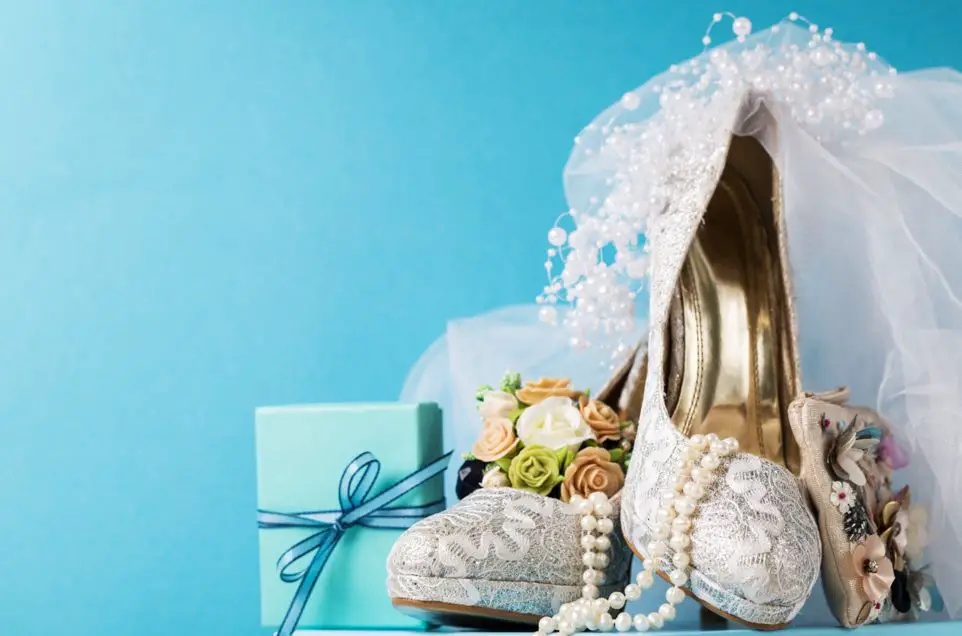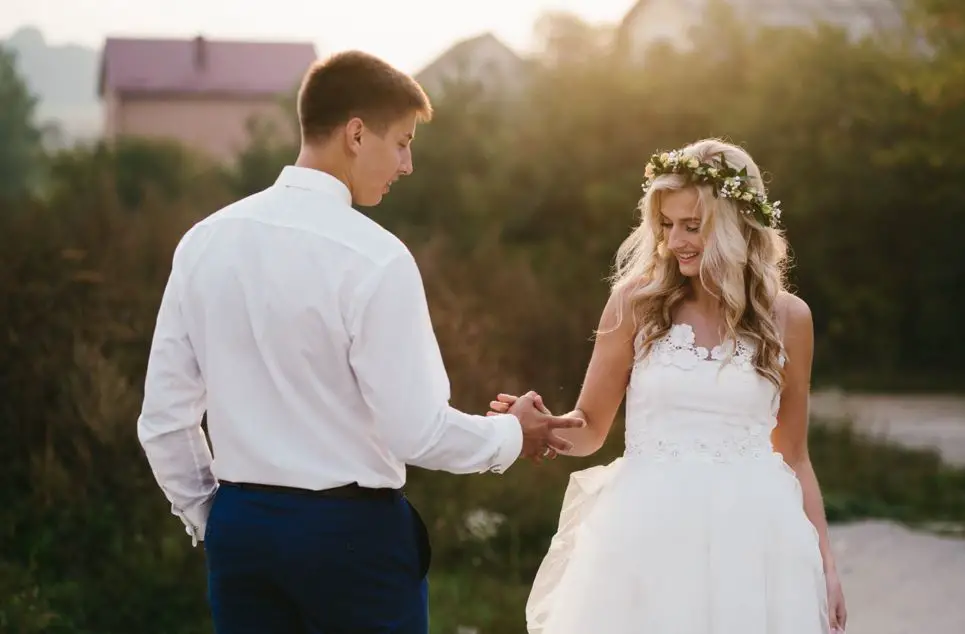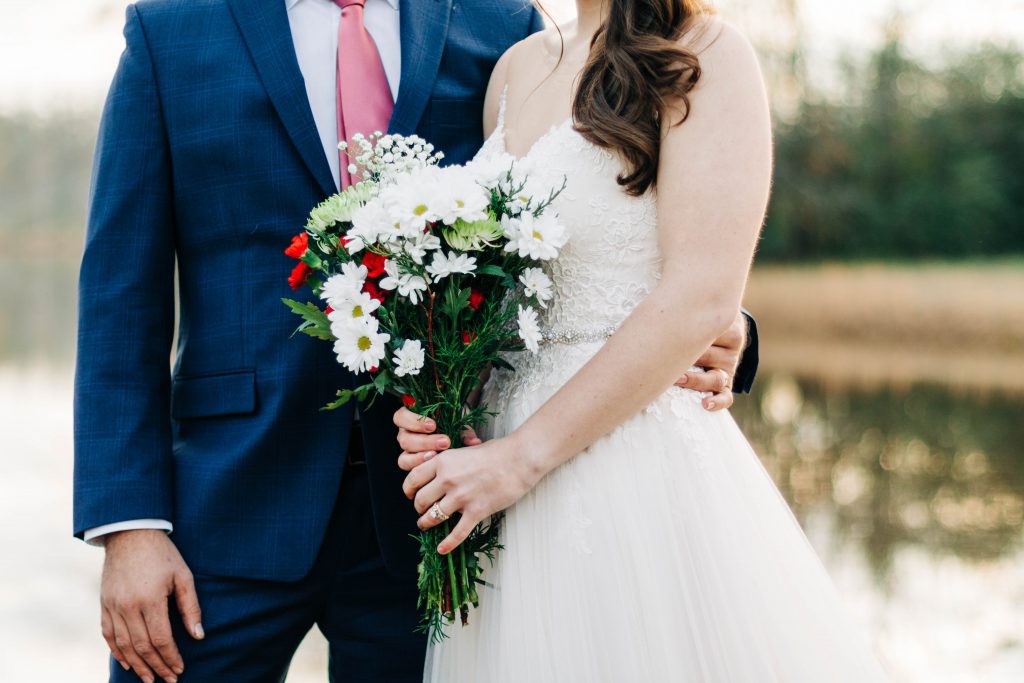On a wedding day, it's customary for the bride to have "something old," "something new," "something borrowed," "something blue," and traditionally, "a sixpence in her shoe." These customs have been observed for centuries, but what is the reason behind them?
This article will explore the origin and significance of this well-known wedding tradition and how it has evolved.
Let’s get straight to the point
The "something old, something new, something borrowed, something blue" wedding tradition dates back to Victorian England and symbolises good fortune for brides. Each item represents a specific meaning:
- Something old: Continuity with the past.
- Something new: Hope for the future.
- Something borrowed: Happiness borrowed from others.
- Something blue: Purity, love, and fidelity.
Additionally, a sixpence in the bride's shoe symbolises wealth and prosperity. While these customs have evolved, many brides still incorporate these elements to personalise their weddings, reflecting their family heritage and individual style.
Origins of the Tradition

The well-known phrase originates from a poem written in Victorian-era Lancashire, England. The tradition has been passed down through generations, and each item represents a symbolic element that is believed to bring good fortune to the bride on her wedding day.
While some of these items were originally intended to protect the bride from misfortune, their meanings have shifted over time. For instance, a garter worn by the bride as her "something blue" was thought to ward off the Evil Eye, a curse that could lead to the firstborn child being stillborn. "Something borrowed," traditionally underwear from a woman who had recently given birth, was meant to trick the Evil Eye into thinking the bride was already fertile. The tradition continues to carry symbolic weight, although most brides today don't follow the old superstitions.
Even though the original meanings have evolved, the tradition of incorporating these four (or five) items remains strong, as each object carries its significance:
- Something old Represents continuity and the bride's past.
- Something new: Symbolizes hope and the future.
- Something borrowed: Denotes happiness borrowed from another.
- Something blue: Signifies purity, love, and fidelity.
For many modern brides, the sixpence—a coin placed in the bride's shoe—isn't as common, especially outside the UK. However, some couples still consider it a charm of good luck.
The Meaning Behind Each Item
1. Something Old
"Something old" symbolises the bride's connection to her past and continuity with her family heritage. Historically, this item was intended to protect the bride’s future fertility, but today, it serves as a nostalgic reminder of family traditions. Many brides incorporate family heirlooms into their weddings, such as jewellery or accessories passed down through generations.
For example, a bride might wear her grandmother’s wedding jewellery or include an antique locket in her bouquet. This trend of using vintage or antique pieces has only grown with the rise of retro-chic wedding themes, allowing brides to integrate history into their special day.
Some ideas for "something old" include:
- Family heirloom jewellery (pins, bracelets, necklaces)
- A vintage locket with family photos
- Lace from a mother or grandmother’s wedding dress
- A classic wedding cake topper used by other family members
2. Something New
"Something new" symbolises the new life the bride and groom are starting together. It signifies hope, optimism, and the excitement of embarking on a new chapter. This item can range from a new piece of clothing to a meaningful accessory or even a gift from the groom or family members.
For most brides, their wedding dress is their "something new," but it could also be a new pair of shoes, jewellery, or any other newly purchased item for the big day. Many brides also opt for new beauty treatments like teeth whitening or a new lipstick to add a personal touch to the concept of "something new."
Examples of "something new" include:
- The wedding dress
- A new piece of jewellery gifted by the groom
- Newly purchased wedding shoes
- A fresh fragrance or a new signature lip colour
- Monogrammed items with the bride's new initials
3. Something Borrowed
The tradition of "something borrowed" is rooted in borrowing happiness from a successful marriage. The bride borrows an item from a happily married friend or family member in to hope that some of that person’s happiness will be passed on to her.
Historically, brides borrowed items like a veil or jewellery, but the options have expanded. Nowadays, it could be anything meaningful borrowed from someone important to the bride, such as a friend’s wedding shoes or a piece of jewellery worn by a family member on their wedding day.
Borrowing also strengthens the relationship between the bride and the lender, symbolising trust and friendship.
Ideas for "something borrowed":
- A wedding veil or headpiece
- A piece of jewellery worn by a happily married relative
- Wedding shoes or accessories worn by a friend
- A bouquet from a family garden or flowers from a friend’s wedding
4. Something Blue
"Something blue" represents purity, love, and fidelity. This tradition dates back to ancient times when blue was considered a symbol of loyalty and faithfulness. In Christian tradition, blue is also associated with the Virgin Mary, symbolising protection for the bride. Historically, brides wore a blue garter to uphold this tradition.
Today, "something blue" can be interpreted creatively, with brides incorporating the colour in various ways. It could be as subtle as blue stitching in a wedding dress or as bold as blue shoes or jewellery.
Creative ideas for "something blue":
- Blue shoes, whether subtle or statement
- Sapphire or aquamarine jewellery
- Blue nail polish or blue accents in the bride’s bouquet
- A blue ribbon sewn into the wedding dress or bouquet
- Blue embroidery inside the dress with the couple’s names and wedding date
Sixpence in the Shoe Tradition
Often overlooked in modern weddings, the sixpence symbolises wealth and prosperity for the newlyweds. This British coin was once commonly placed in the bride's shoe as a good luck charm. Though no longer in circulation, brides with a sense of tradition or superstition may still seek a sixpence for their wedding day. Alternatively, brides may use a penny or a coin from a special year, such as when they met their partner or their birth year, as a modern twist on this tradition.
If you can’t find a sixpence, a penny can be a substitute, and it is often taped inside the shoe as a gesture of good luck.
Adapting the Tradition in Modern Weddings

Many modern brides and grooms have found ways to adapt these traditional elements to reflect their tastes and values. For example, brides may incorporate blue details into their attire with accessories or makeup, while grooms might wear their grandfathers' ties as "something borrowed."
Other creative interpretations of the tradition include:
- Bridesmaids wearing blue dresses as the "something blue"
- Including a piece of lace or fabric from a loved one’s dress in the bride's outfit as "something. g old"
- Grooms offer jewellery gifts to the bride as if they are something new."
- A friend or family member lending a significant item for the "something borrowed" part
In some cases, brides even skip some elements of the tradition entirely, instead focusing on the most meaningful elements. Regardless of whether all parts of the rhyme are followed, this tradition remains a beloved aspect of weddings.
Conclusion
The "something old, something new, something borrowed, something blue" tradition has endured for generations, offering brides a meaningful way to incorporate personal and family history into their wedding day. Originating in Victorian-era England, the custom continues to evolve, allowing modern couples to express their individuality while maintaining ties to the past. Whether you follow the tradition of the letter or adapt it to suit your unique style, the sentiment behind these simple items remains timeless: to bring luck, love, and joy to the newlyweds' future together.
So, whether you’re donning a family heirloom, borrowing a friend’s veil, or simply adding a touch of blue to your ensemble, remember that these small gestures are a way of connecting the past, present, and future as you embark on your new journey as a married couple.
FAQs About Wedding Accessory Traditions
A bride is advised to wear "something old" on her wedding day in the hopes of ensuring a long and happy marriage, as part of the "Something new, something borrowed, something blue" custom. Also, it doesn't make a tonne of sense, just like most superstitions.
Naturally, there are a plethora of psychologically and scientifically supported strategies for improving marital satisfaction. But donning those four items is a custom that many people prefer to retain
Hopefully, their good fortune will rub off on the new couple. According to some accounts, the garment was originally designed to protect its wearer from the vengeful glances of rejected suitors, who may otherwise cause the woman to remain childless. For this reason, it was suggested that the bride wear "the undergarment of a woman who has been blessed with children," as this would "convey fecundity to the bride."
Those modern brides who wish to observe the sixpence custom typically use a penny or another tiny coin in its place. Although the custom of the bride wearing "something old, something new, something borrowed, and something blue" is rather obsolete, many modern brides still like it
A swatch of the bride's dress was once ripped off by well-wishers as a lucky memento. Eventually, this peculiar custom evolved into the bouquet and garter tosses we know today. Even though these customs are meant to be lighthearted, few people actually look forwards to participating in them. This is especially true for ladies who have to run about in high heels to catch the bouquet, and few people who have to dive to the floor to get the garter.
You may be fortunate enough to get some of these lucky tokens as gifts or loans from family members or your future spouse, but there's no rule that says you can't also collect a few pieces on your own.

